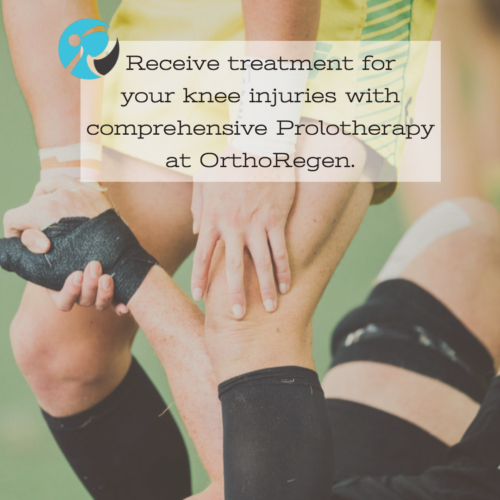
Chondromalacia Patella Can Be Treated with Prolotherapy
In Chondromalacia Patella, the kneecap tracks abnormally making everyday activities difficult, interfering with sports, and causing knee pain. The condition is common in runners and athletes, especially in activities that involve a lot of running. And it can affect young, healthy individuals, as well as older adults. Chondromalacia patella is one of the causes of patellofemoral pain syndrome.
Chondro means cartilage, malacia means breakdown, and patella means knee cap. So, when someone suffers from this condition, they will have cartilage breakdown and fraying underneath the knee cap.
Excessive, abnormal movement or hypermobility of the knee is considered a contributing factor in the development of chondromalacia patella.
Normally, the patella slides easily along the smooth surface of the patellar groove with bending and straightening of the knee. But with chondromalacia patella, the cartilage becomes rough and wears away.
The symptoms of chondromalacia patella include pain around the kneecap and clicking, cracking or popping sounds. And these tend to exacerbate with activity and worsen over time.
The kneecap ends up scraping the bones underneath the knee when the person moves the knee. The patella, or kneecap, is the largest “sesamoid” bone in the body, and it plays a crucial role in the bending and straightening of the knee. When there is a problem with the patella, the knee joint becomes unstable and movement becomes difficult and/or painful.
Chondromalacia Patella is a type of patellar pain syndrome. And these syndromes often involve problems and injury of other soft tissue structures. Patellar pain syndromes are often due to ligament injuries, meniscal tears, bony aberrations, muscle imbalances, or a combination of these conditions.
Patellar pain syndromes can be caused by trauma. But they are primarily due to anatomic or bio-mechanical conditions that are prone to “failure” either in a bone or soft-tissue component. That means there may be injured ligaments or injured tendons, which are actually part of the underlying problem and adding to the tracking issue. If these other soft tissue injuries are not treated, the knee will remain unstable, creating a negative cycle and resulting in significant impairment.
Taping, strengthening exercises, and stretching are typical treatments for Chondromalacia Patella. These treatments may work for a short period of time. But generally do not cure the condition. Regenerative Orthopedics, on the other hand, can improve patellar tracking and relieve the symptoms of Chondromalacia Patella.
Physical therapy, to strengthen the quadriceps may be an important treatment component in Chondromalacia Patella. However, if the quadriceps tendon or other soft tissue, like ligaments are injured, then they need to be treated, because physical therapy success will otherwise be limited.
Let’s explain further. If the soft tissue component is not treated, the joint will remain unstable, the abnormal movement will continue, the negative cycle is promoted, and the impairment and altered tracking of the patella will persist. Physical therapy, patellar taping, orthotics, ice applications, and soft braces do not address the underlying issues of joint instability caused by the ligament injury, tendon injury, or meniscal tears.
Surgery is becoming more and more common for various knee conditions, and in some cases may be indicated. But unless a person is dealing with a fracture or a complete ligament rupture, a more conservative option should be considered.
It is very possible that you have already tried various treatments, and even employed them over and over. But they continue to fall short in bringing you the relief and return to function and sport that you desire. Regenerative Orthopedics, on the other hand, can promote non-surgical repair of the ligament, tendon, and meniscus. And have been utilized with positive outcomes for patellar pain syndromes like Chondromalacia Patella.
Regenerative Orthopedics is a therapeutic option that can promote the repair of injured or degenerated soft tissue. The treatment boosts the physiologic healing processes of the joint, thereby ameliorating joint instability and potentially all of the related conditions above. Stem Cell Therapy, PRP, and Prolotherapy are regenerative techniques well suited for soft tissue injury of the knee joint. And they have been used to effectively treat a wide variety of knee pain conditions, including Chondromalacia Patella.
Soft tissue injuries of the knee often have an unsatisfactory outcome due to incomplete healing and repair. Regenerative Orthopedics is a treatment technique that has been explored for conditions that require soft tissue healing, with the goal of restoring normal ligament and tendon function. Regenerative Orthopedics is a conservative treatment that reduces Chondromalacia Patella symptoms, improves function, and restores normal tracking of the patella, returning you quickly to the sport and activities you enjoy.